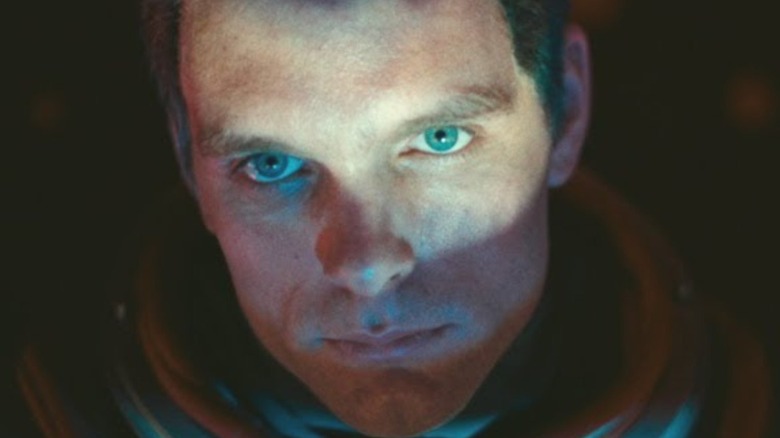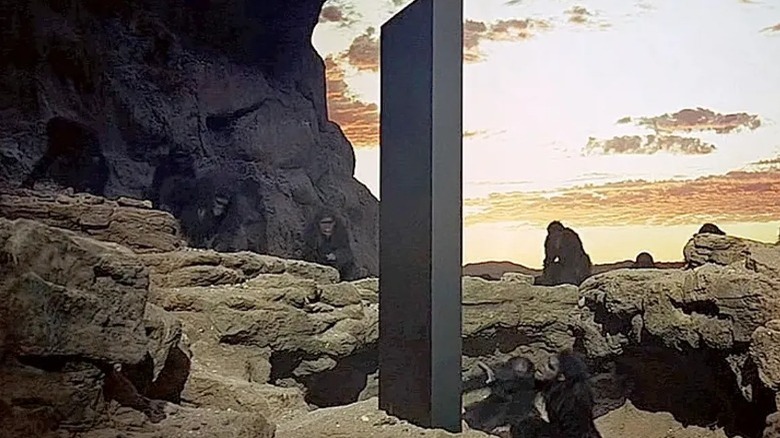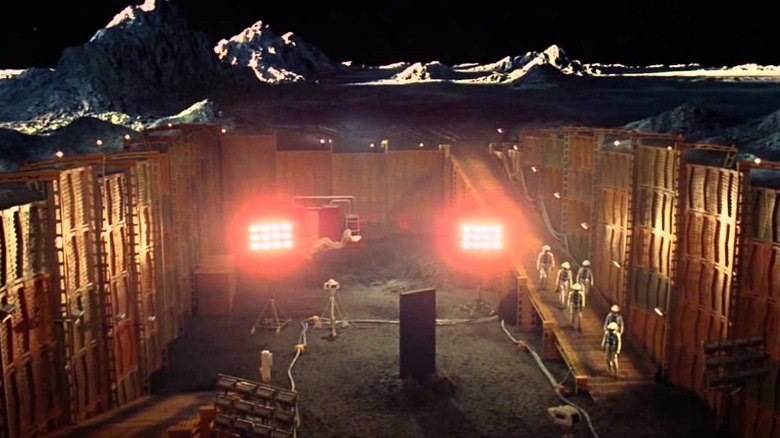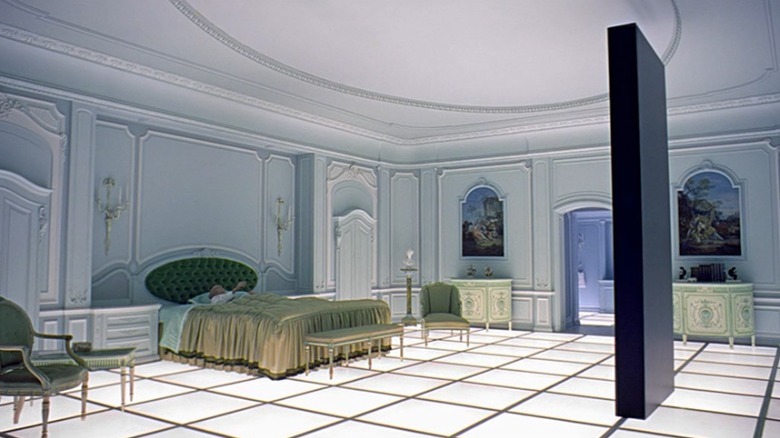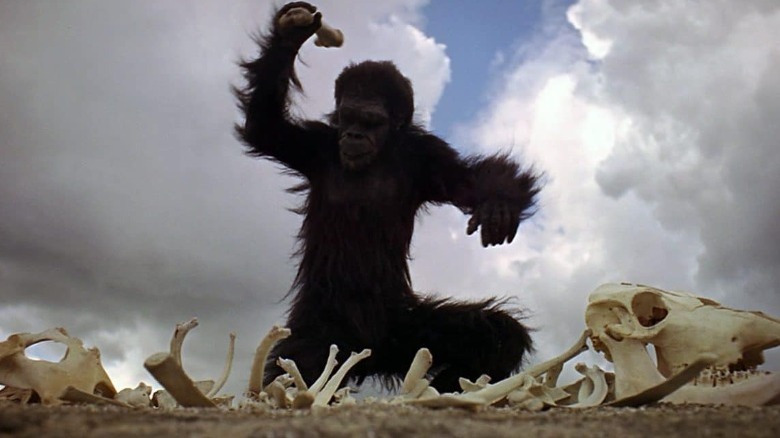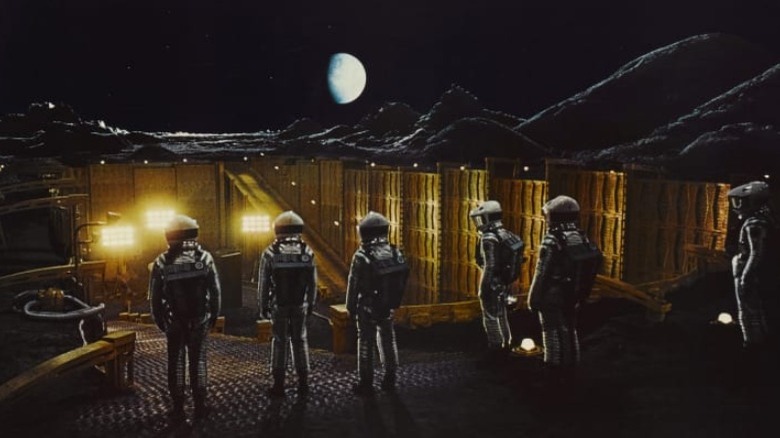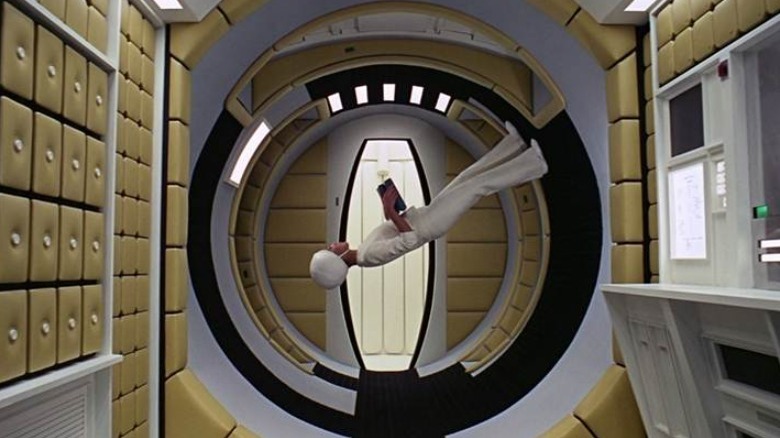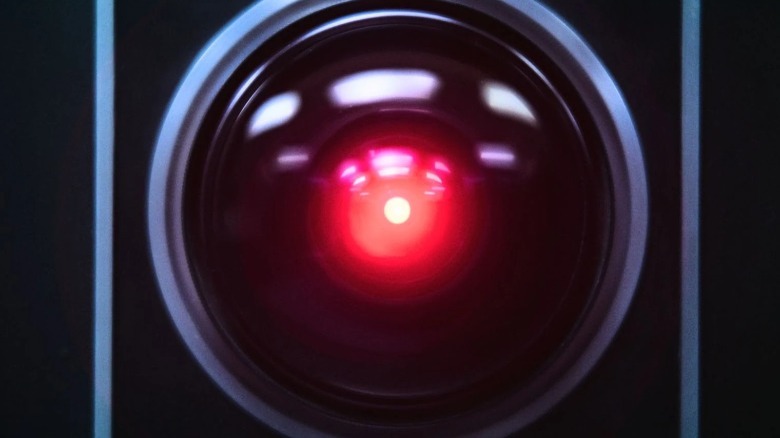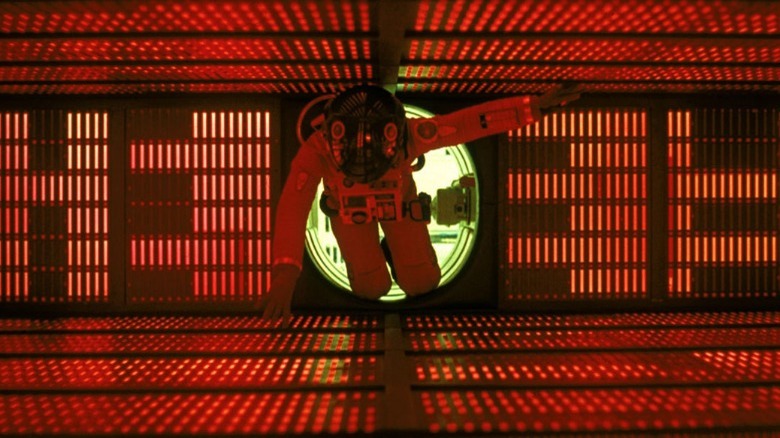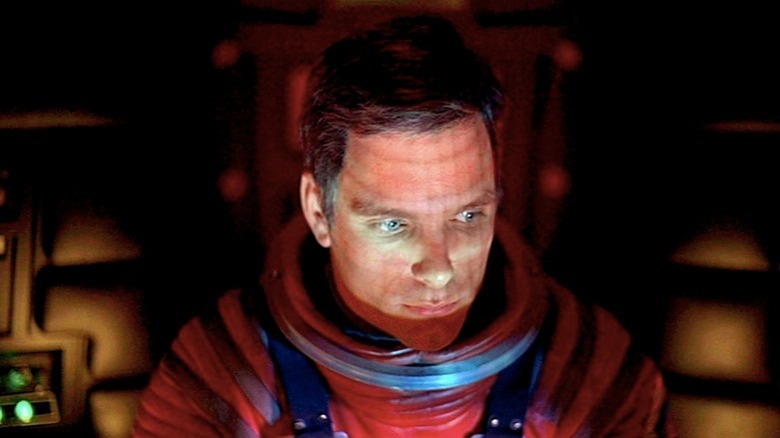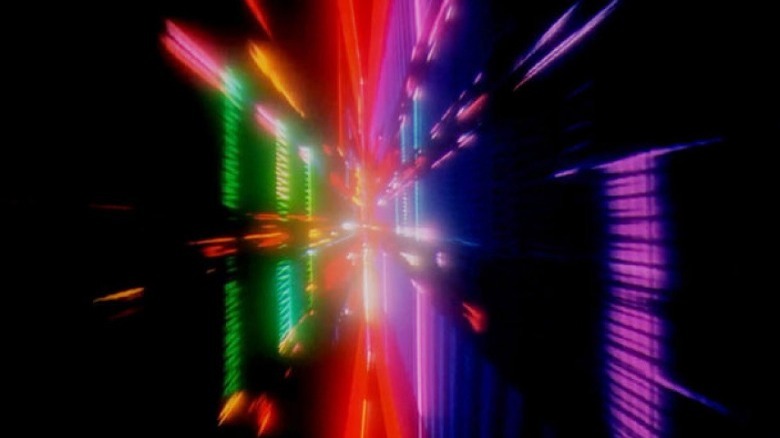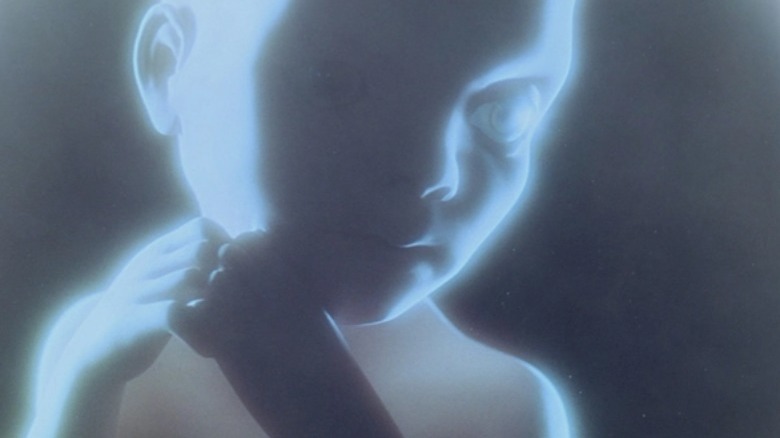2001: A Space Odyssey's Most Confusing Moments Explained
Developed as a joint project between director Stanley Kubrick and noted science fiction author Arthur C. Clarke, "2001: A Space Odyssey" has become one of the most discussed and important films in history. A lot of that is down to the fact that the film is so open to interpretation and confusing to viewers, with only a small amount of dialogue to help explain exactly what is happening (via No Film School). Add in the fact that it deals with concepts like space travel, artificial intelligence, philosophy, and the evolution of man, it is little wonder that it has caused so much confusion over the years.
That isn't all that surprising, given how Kubrick was known for his more cerebral work demands multiple viewings to fully understand. Just look at "The Shining" and its baffling ending as another example of such storytelling. However, that doesn't mean that "2001: A Space Odyssey" is completely opaque and cannot be understood. Film scholars, analysts, and even Kubrick and Clarke themselves have spoken at length about the movie and exactly what it means. Here are some of the most confusing moments from the film and some explanations that shed some much-needed light on them.
What are the Monoliths?
The Monoliths themselves are one of the greatest mysteries in "2001: A Space Odyssey." They drive the action forward upon their discovery and play important roles in pivotal moments of mankind's history. Yet, they don't actually outwardly appear to do anything at all, and "2001" doesn't show how they work or what they are designed for. Instead, they are immovable black slabs — clearly designed rather than naturally occurring due to their straight lines and minimalist design.
Despite the enigmatic nature of the Monoliths, the one thing that is plain to see about them is that they are closely tied to humanity and have some sort of effect on the species (via Shmoop). Their exact nature and origin are never explicitly stated. Still, it can be inferred that they have been built both to monitor humans and exert some sort of control over humanity's evolutionary course (via Visual Memory). Each particular Monolith also demonstrates a specific function. For example, the device on the moon is a signal, sending information in the direction of Jupiter. Meanwhile, the larger Monolith encountered at the end of the film is a stargate, transporting Dave across vast distances.
Strangely, the Monoliths also have a kind of religious element. They are treated with what can only be described as reverence by those that find them. They create a sense of awe and wonder in an almost spiritual manner, in large part due to how otherworldly and transcendent they are (via Roger Ebert).
Who built the Monoliths?
While the Monoliths are no doubt mysterious, they must have been built by someone. They're simply too perfect in shape to be a natural phenomenon, meaning someone — or something — designed them (via Shmoop). Whoever these beings are, they must be far more advanced and technologically capable than humans. After all, the Monoliths would have been constructed and hidden away millions of years ago while humans were nothing more than primitive beasts. In many ways, such a civilization could be considered almost god-like.
Perhaps this is why Stanley Kubrick was so set against ever showing or describing the aliens responsible for the Monoliths. While the director freely spoke about the fact that these aliens existed within the movie, he did not want to give them a visual identity as this would not be as effective or impressive as allowing the audience to picture them in their own heads.
He explained in an interview with Joseph Gelmis (via Visual Memory) saying, "From the very outset of work on the film we all discussed means of photographically depicting an extraterrestrial creature in a manner that would be as mind-boggling as the being itself. And it soon became apparent that you cannot imagine the unimaginable." So, he instead decided to use the Monoliths as a representation of the aliens (via Far Out Magazine).
Author Arthur C. Clarke was more explicit about the alien civilization in later novels. In "3001: The Final Odyssey" he called them the Firstborn — impossibly old beings who have shed their physical bodies and roam space as they search for new life.
What do the Monoliths actually do?
Understanding who built the Monoliths and what they are doesn't fully explain their purpose or workings. The Moon Monolith, for example, sends a signal to the Monolith near Jupiter, but why? To get a full picture of these machines, it is necessary to look back at the very first one in the film.
After a group of ape-like early humans comes across the first Monolith, they begin to develop a deeper intelligence, using tools and weapons to become the superior group and defeat their competitors. In that sense, this Monolith serves as an accelerant, increasing the evolution and advancement of those that find it. It essentially gives humans a push in the right direction to ensure they head along the right evolutionary path (via Film Site).
The Moon device has a similar purpose, though it's more subtle, pointing humanity to Jupiter so they can continue their journey towards their final form. It also acts as a beacon and test, as it can only be discovered when technology on Earth has advanced sufficiently and tells its creators that humans have reached a point where they can travel in space.
On a deeper level, some interpretations of the film suggest they could also represent our own reliance on technology. The Monoliths, with their rectangular shape and black coloring could be a symbol for screens, according to film analyst Rob Ager.
What's with the ape scene at the beginning of the movie?
The opening moments of "2001: A Space Odyssey" sees a group of ape-like, early homininis, driven away from their land by a rival group. Because they discover a Monolith, they are able to understand that things can be used as tools, learning how bones make useful weapons. This newly enlightened clan then fights off the rival group and kills its leader. The Monolith is key to this scene, as it imparts knowledge to the creatures and helps them come to a new level of intelligence (via Roger Ebert).
In Stanley Kubrick's 1970 interview with Joseph Gelmis (via Visual Memory), the director spoke about his desire to not become too literal with his depiction of what the Monoliths are doing in the film. He wanted to give "2001: A Space Odyssey" a more enigmatic nature so it was open to interpretation, so exactly what the Monoliths are doing or how they operate is never made fully clear.
Although Arthur C. Clarke did go into more detail in his novel about what the Monolith was actually doing to the primitive creatures. David K. Johnston explains how in the book the Monolith gives the creatures visions of how to perform certain actions and create specific tools. It effectively acts as a sort of learning device, testing whether these lifeforms have the potential to become sentient and reach an advanced state of intelligence.
Why is the monolith on the moon kept secret?
Almost immediately after the scene where the early humans kill the rival leader, a jump cut thrusts us into the future. Humanity has now reached the stage where it can travel in space and has even established several bases on the Moon. One of these is Clavius Base, an outpost that Dr. Heywood Floyd is visiting when he is questioned by Russian scientists about why the base has shut off all communication. Floyd is coy and doesn't reveal any information that the American team has discovered a second Monolith buried beneath the Moon's surface. A cover story has even been developed to provide a reason to deny access to anyone who is attempting to come to Clavius Base, falsely claiming there is some sort of disease outbreak in the facility.
Some hints about why this secrecy is necessary are given in the mission briefing scene when Dr. Floyd talks about the panic that could be caused by revealing that alien life exists to a population that hasn't been prepared or conditioned. However, there's more at play here as well. "2001: A Space Odyssey" was released at a time when the Cold War was still very much a genuine threat (via BBC). Kubrick has employed anti-war themes throughout many of his films and this movie was originally going to include a storyline about nuclear satellites that would be destroyed. In this context, the secrecy is likely the government wanting to keep any knowledge or intelligence that can be gained from the Monolith to themselves and out of the hands of potential enemies.
How do the astronauts walk on the ceiling?
David Bowman and Frank Poole are on board the Discovery One on the way to Jupiter, although they are not fully aware of what their true mission is. In one of the most memorable scenes in the entire film, one of the astronauts is shown jogging around the outside of a room, seemingly going upside down without falling. A similar scene from earlier in "2001: A Space Odyssey" shows a woman grabbing food and then walking up the wall until she is on the ceiling.
There are two ways to explain this. The first deals with the in-film universe and the explanation for why such movement is possible. On Discovery One, the astronauts are able to freely move around the spacecraft like that because of artificial gravity (via Wired). Meanwhile, the Pan-Am air hostess has a special pair of Grip Shoes, which can be seen here in a close-up, that allows her to stick to the wall while walking (via CNET).
The second answer explains how Stanley Kubrick and the crew were able to realistically depict such an action. Using a technique that had been utilized in an earlier Fred Astaire movie "Royal Wedding," the entire set was rotated, and the camera was fixed in place. This gave the effect of the person moving as the set and camera moved around them. To achieve the effect, Kubrick had a giant Ferris wheel structure developed to house the set (via ASC Magazine).
Why does HAL decide to kill the astronauts?
As well as being one of the most famous computers in history, HAL 9000 is also the primary antagonist in "2001: A Space Odyssey." An artificial intelligence, he was created to control most of the systems on Discovery One and assist the crew in their missions. He communicates with Dave and Frank, keeps the ship running in a proper manner, and is essential to overall operations.
That all changes, though, when he begins to show signs of malfunction. Dave and Frank, having discussed the issue with mission control on Earth, believe that HAL 9000 is behaving erratically and intend to shut him down to prevent disaster. Despite the precautions they take to avoid the AI from overhearing what they see, it is able to lipread and learn of their plan. HAL 9000's next actions are prompted by two motives. One is that it cannot allow its mission to be halted because it is too important. Secondly, the AI has clearly developed some sort of fear about being disconnected or "killed" due to its sentience. In this interpretation, HAL 9000 acted only in self-defense to prolong its own existence.
Kubrick spoke about this in an interview, saying that such an AI with higher brain functions would "develop an equivalent range of emotional reactions — fear, love, hate, envy, etc. Such a machine could eventually become as incomprehensible as a human being, and could, of course, have a nervous breakdown."
What was HAL's mission?
An important way to help make sense of what happens in "2001: A Space Odyssey" is to read Arthur C. Clarke's novelization. Although it makes some changes to the story, it is a useful guide to some of the more mystifying elements that might confuse viewers. A good example of this is the AI HAL 9000 and its motivations and purpose. Those who have seen the film will know that there was a second hidden mission for the Discovery One, a mission that Dave and Frank were unaware of but that the ship's AI was programmed to complete.
The true purpose of Discovery One is to investigate the radio signal sent from the Monolith discovered on the Moon to Jupiter, with the hope of establishing contact with an alien civilization or discovering more advanced technology (via Brian Eggert). The novel suggests that this mission and the fact that HAL 9000 was created to be as accurate as possible is what caused it to malfunction and kill the crew.
The AI was trying to solve a paradox created by the fact that it was supposed to be unable to provide false information, in this instance lying to the crew, but was also being forced to hide the true mission from Dave and Frank (via Gizmodo). The solution that HAL 9000 comes up with in this situation is simply to get rid of the crew so it no longer has to lie.
Would Dave actually survive in space without a helmet?
When HAL 9000 decides he needs to kill the crew to survive, Dave is locked out of the ship when he tries to rescue Frank. Needing to leave the safety of his own pod and enter the vacuum without a helmet to keep him pressurized and supplied with oxygen, he manages to reach the airlock after being exposed for just over 10 seconds. With film audiences conditioned to believe that the slightest exposure to space would lead to explosive decompression, just how accurate is this scene?
It turns out that it certainly would have been possible if events panned out the way they did in the film. How Stuff Works indicates that a person wouldn't immediately die and could last up to two or three minutes in total before permanent damage took hold. This is because the various effects take a little while to start, with Film School Rejects noting that the experience wouldn't be pleasant but would likely have worked and given Dave a chance to survive.
What actually happens at the end of the film?
Perhaps the most baffling part of "2001: A Space Odyssey" is the ending, which is impressive considering just how confusing the rest of the film can be. After encountering the Jupiter Monolith, Dave is taken away on a journey that involves striking colors and strange special effects, ending with Dave being transported out of the spaceship and emerging in a decadent room. As he searches his surroundings he encounters several older versions of himself until one of them is an old man in a bed who seemingly dies before being reborn as a fetus.
Each Monolith has led to some sort of advancement in humanity and the Jupiter Monolith is no different in that respect. In Kubrick's own words the device "sweeps him into a force field or star gate that hurls him on a journey through inner and outer space and finally transports him to another part of the galaxy, where he's placed in a human zoo approximating a hospital terrestrial environment drawn out of his own dreams and imagination. In a timeless state, his life passes from middle age to senescence to death."
Like in other parts of the film, Kubrick wanted "2001: A Space Odyssey" to be subjective and mysterious. He wanted the audience to have their own interpretations rather than simply be told what is going on. But, as noted above, he was more than happy to lay out the events in a factual manner.
Why is Dave transformed into a star child?
At the conclusion of the ending sequence, Dave is transformed into a fetus that is then sent back to Earth. The meaning behind this and his new purpose is arguably the most confusing element of the entire film. In early drafts, this new entity would have removed the nuclear threat around Earth by destroying the various satellites housing the weapons. But that doesn't happen in the final version of "2001: A Space Odyssey." Instead, he seems to watch over the planet with a thoughtful gaze before the experience ends.
Kubrick himself said that Dave "is reborn, an enhanced being, a star child, an angel, a superman, if you like, and returns to Earth prepared for the next leap forward of man's evolutionary destiny." According to Shmoop, the astronaut has his reliance on technology removed as his suit, pod, and even body are taken away from him as he begins his transformation into something new.
Professor David K. Johnson argues that the novel's explanations help to make sense of the film. Dave has been pushed to the next evolutionary stage for mankind, becoming like the aliens that created the Monoliths themselves, a type of energy being free of his physical form. Roger Ebert suggests that this may well be Kubrick's own hope of what humanity might become in the future.
